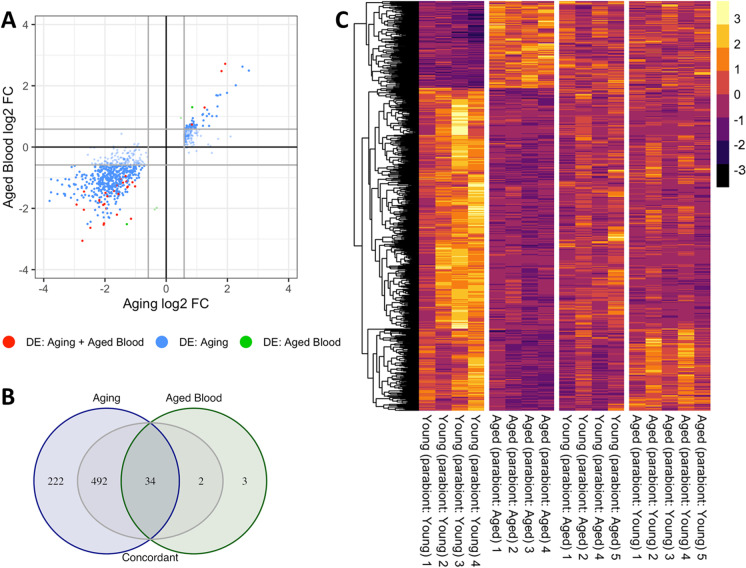Fig. 2.
Old blood promotes aging-like changes in vascular mRNA expression profile: identification of concordant genes Panel A: Old blood-induced changes in gene expression (log2 fold changes; heterochronic parabiont young [Y–(A)] mice vs. isochronic parabiont young [Y–(Y)] mice) plotted against age-related changes (log2 fold changes; isochronic parabiont aged [A-–(A)] mice vs. isochronic parabiont young [Y–(Y)] mice) in the aortic transcriptome. Red symbols indicate concordant differentially expressed genes, whose expression significantly changes with age, and the direction of this effect is mimicked by exposure to old blood. Blue and green symbols denote concordant genes, whose expression similarly changes in aging and by old blood exposure, but only the aging (blue) or the old blood effect (green) reaches the cutoff for statistical significance. Panel B: Venn diagrams showing the numbers of differentially expressed mRNAs in each group. The blue circle represents genes, which are significantly up- or down-regulated in aged mice as compared to young mice. The green circle represents genes, which are significantly up- or down-regulated by the presence of old blood in young mice. The intersection of the two circles represents concordant differentially expressed genes. Grey areas represent concordant genes, whose expression similarly changes in aging and by old blood exposure, but only the aging or the old blood effect reaches the cutoff for statistical significance. Panel C: The heat map is a graphic representation of normalized expression values of concordant genes in aorta samples derived from Y–(Y), A–(A), and Y–(A) mice. Data for aorta samples derived from A–(Y) mice are shown for comparison. Note that the expression of the majority of concordant genes, which are down-regulated by old blood in young mice, is unaffected by the presence of young blood in old mice. These data indicate that many of the effects of pro-geronic factors, which induce accelerated aging phenotypes in young mice, cannot be rescued by the presence of young blood in old mice

